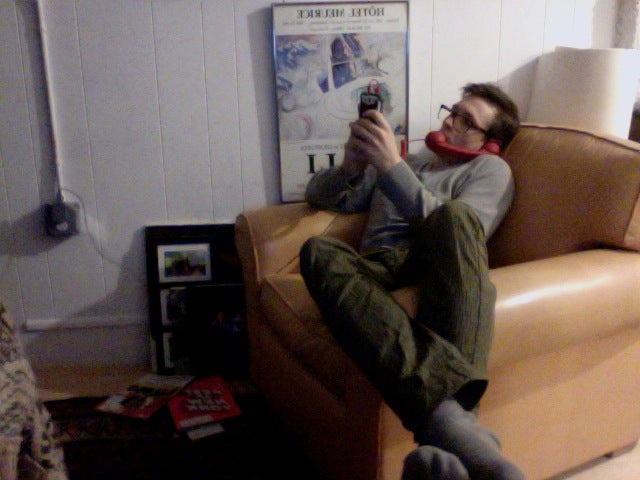
Los Angeles-based street artist Saber holds the world record for the largest piece of graffiti in history. In 2012, he hired five skywriting planes to paint "aerial graffiti" in the sky in response to Mitt Romney's plan to eliminate the National Endowment for the Arts if elected president. But as time has gone on, Saber has transitioned into a gallery setting. On Friday he opened a new show at The Outsiders gallery in London called "The Ugly American," which runs until Feb. 15.
This London exhibition initially opened at The Outsiders' Newcastle location and was Saber's first European solo show. "The Ugly American" is based on and named after the 1963 Marlon Brando film The Ugly American. We had a chance to catch up with Saber via email about his new exhibition.
I put my love and time into these pieces, adding a little vulnerable piece of myself to these inanimate objects.
Tell me about this show. Why did you decide to call it "The Ugly American"?
We all have a little Ugly American in us.
Doesn't going on to desecrate the Union Jack simply perpetuate that role?
This is a funny question considering I don’t think we can get any more desecrated at this point. Once an image represents oppression to others, as well as being used for T-shirts turned into dirty wash rags, it is only up from here. I feel I am doing the exact opposite, more like an example of sanctification than desecration. I put my love and time into these pieces, adding a little vulnerable piece of myself to these inanimate objects.
To me, there is a difference between the representation of politics and the politics of representation. How do you think your work engages socially, beyond when federal aid money was used to paint over your record-breaking piece in the LA River?
This is a difficult question to answer without looking at the work in comparison. First and foremost I want the paintings to be given merit by the viewer with the quality and attention to detail. Then, any barriers or preconceived attachments they have with the icon can be personally examined. This is more specific to the flag series because we are dealing with an obvious icon. The other styles I paint are free from this faux pas.
You've been very vocal about your trials with epilepsy and your lack of access to health care. Has the recent battle for universal healthcare—and its eventual passing—had an effect on your work, mentality, or health?
I hope so. We will see. Fuck the health insurance mafia...
I believe access to the arts is one of the most important aspects of a thriving, balanced society.
When you took to the skies in 2012, you chose to defend arts funding above all the other issues at stake in that election. As an artist who learned largely on the streets, why was this the issue important to you?
I believe access to the arts is one of the most important aspects of a thriving, balanced society. Without this access, the youth have less opportunity to engage a deeper sense of self, as well as moments to practice critical thinking skills. As artists from all Chandras, we need to acknowledge the chain we are all connected to in reference to its own thriving economy.
Some graffiti is impossible to ignore, but as graffiti became more commonplace as an artistic or political act over the last couple decades, it seemed to lose some potency. Is that in part why you hired skywriters to broadcast your message? I guess I'm asking exactly where this skywriting idea came from.
The skywriting came from my own fear and desperation to get the authorities off our backs. I originally was going to see the cost on writing #FREEREVOK over county jail. Then, as time moved on, the project morphed into addressing the Mural Moratorium in Los Angeles. After seeing the overwhelming success of this tactic, New York was an obvious target—at that time arts funding was a current topic to address—and I have fun doing it.
How has it felt to come from being called one of the greatest graffiti writers in the world to a relative newcomer in the fine art world?
HA!! Thanks, “greatest” is a little dramatic, but I’ll roll with it. I’ll forward this question to any collectors who haven’t Googled me yet. I try to keep the two worlds separate. I have been a painter outside of graffiti for many years. It just so happens this culture is a good point of reference to build upon. My goal was always to be remembered through my art, and this is just another way to exercise my demons while learning about the wider art world. I am not going to front and just try to rely on some fleeting fame within a niche culture. I am a damn good painter, and that is enough to start with. The paintings will outlast any wall as time goes on anyway.
Graffiti carries a big stick; the art world poisons your tea while propping you up.
What are the most surprising things you’ve found about the gallery system? What similarities are there between the world of graffiti and the gallery system?
The similarities are: I am still dealing with egomaniacs and alpha assholes. Sociopaths have always fascinated me. Understanding business is key unlike the act of painting for my crew or myself. Graffiti carries a big stick; the art world poisons your tea while propping you up. Both have self-destructive aspects as well as rewards. The challenge is to create a long lasting balance as well as an upward trajectory.
Follow Saber on Twitter (@saber) and Instagram (@saberawr).
RELATED: The 25 Greatest LA Graffiti Writers

